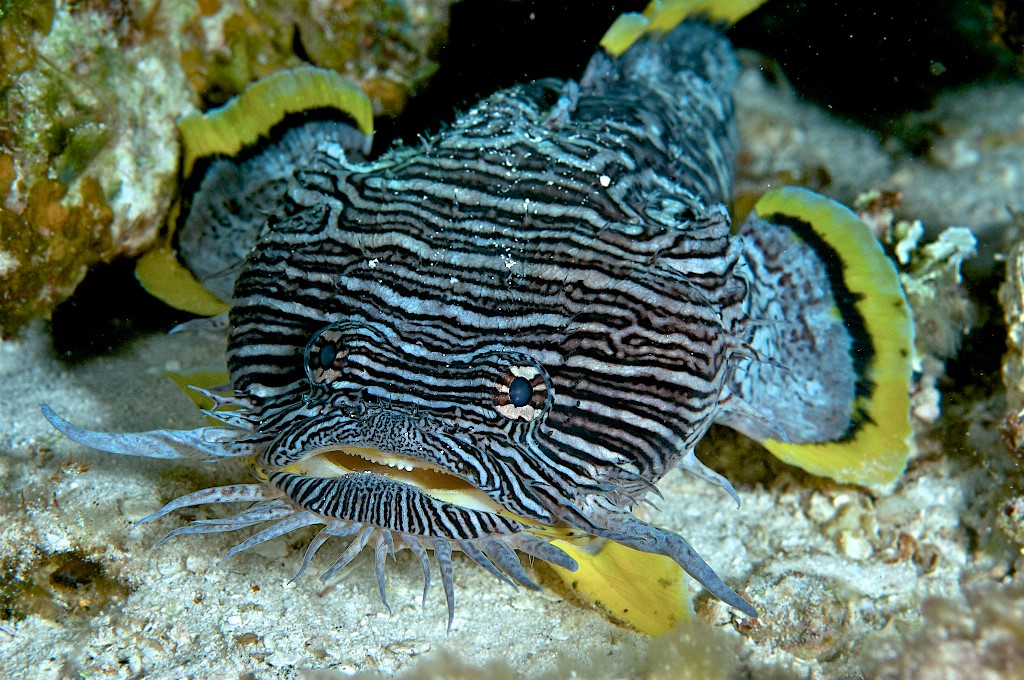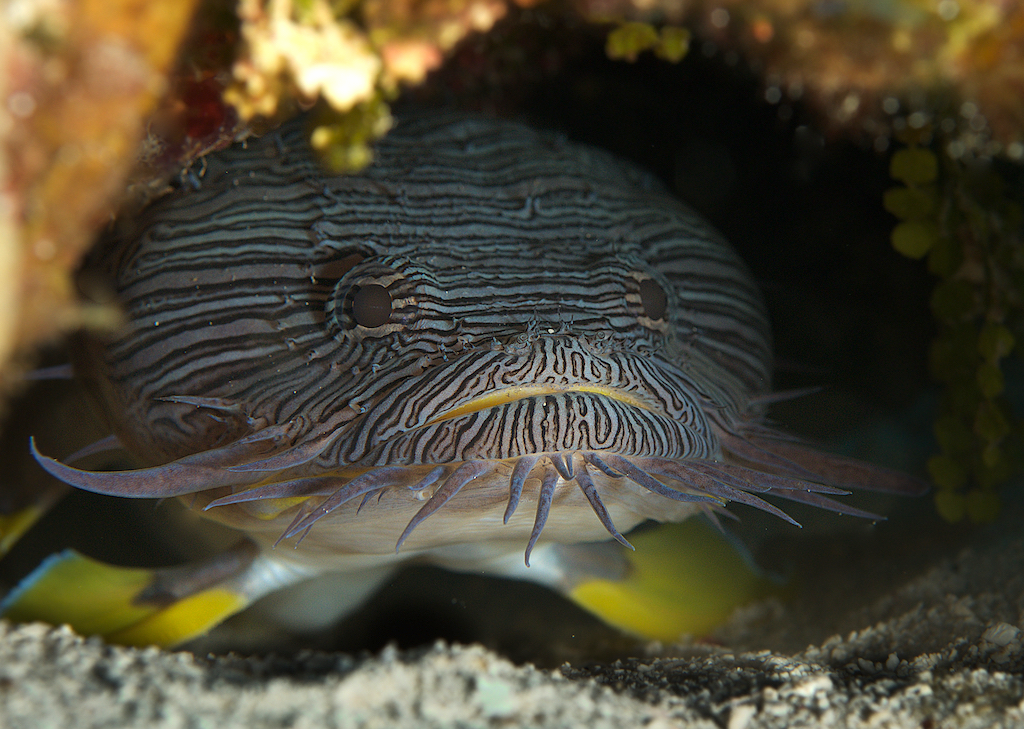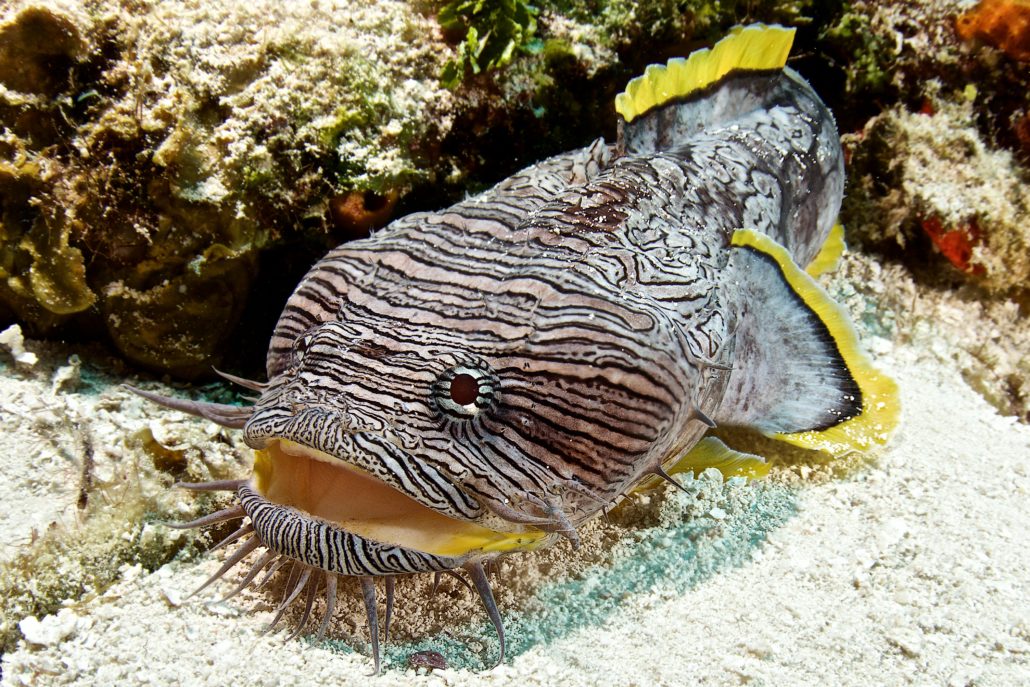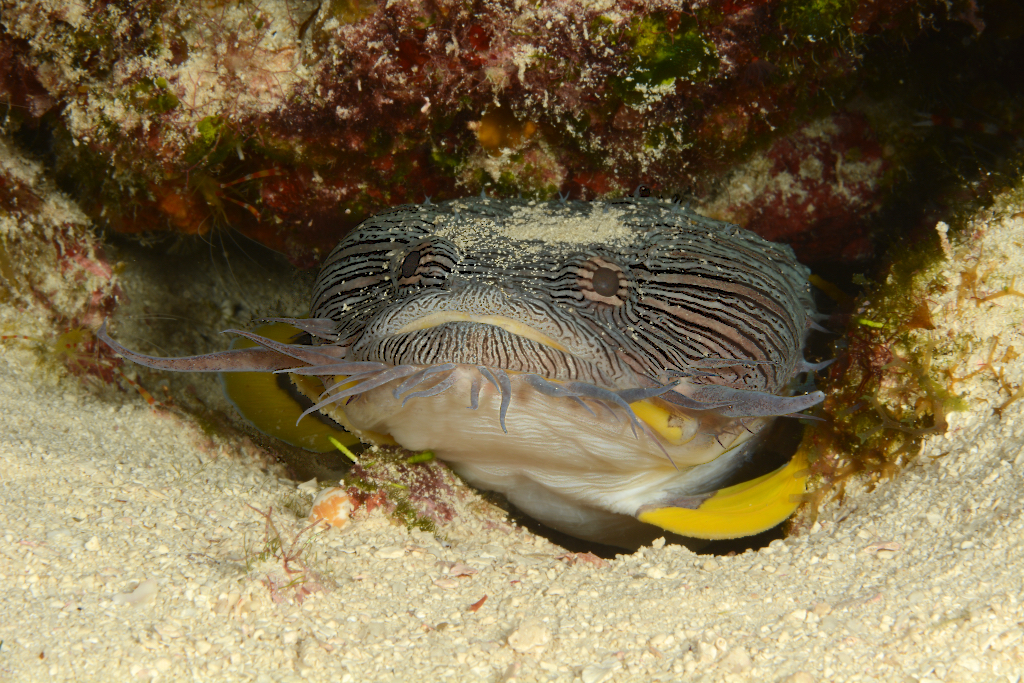The Cozumel Splendid Toadfish

The Splendid Toadfish. © Steve Rosenberg 2019
The Cozumel Splendid Toadfish
By Steve Rosenberg
The Island of Cozumel is a popular Caribbean dive destination located just off the eastern edge of Mexico’s Yucatan Peninsula. Divers will find many unique and beautiful reef fishes. No other reef fish is so closely identified with Cozumel scuba diving than the Splendid Toadfish. This fish has many other common names, such as the Cozumel Catfish or the Cozumel Toadfish. The Splendid Toadfish, Sanopus splendidus, is a very colorful species of toadfish. It is “almost” entirely endemic to the shallow waters around the island of Cozumel. It is occasionally seen on a few near shore reefs of the Yucatan peninsula near Playa Del Carmen.
Splendid Toadfish have vibrant, bright yellow fins and distinctive patterning, unlike other toadfish that exhibit a typically drab coloration. This very distinctive fish has a wide compressed head with whisker like appendages called barbels growing from its lower jaw. It has horizontal charcoal gray striping over white on most of its body. All of the primary fins have a bright yellow border.

The toadfish has a flattened head, with wide powerful jaws. © Steve Rosenberg 2019
The two large rounded pectoral fins, which resemble ears, can be found protruding from either side of its flattened head. The midline of the upper body has a long flowing yellow dorsal fin. There are two small yellow pelvic fins on the undside, just in front of the pectoral fins. When you look at the fish from the front, the toadfish appears to perch on these two fins.
The Splendid toadfish grows to a maximum length of about 12 inches (31cm). Like most species of fishes that dwell close to the sand, the splendid toadfish has eyes located on the top of its head which look directly upwards, allowing it to find potential prey. They possess small, sharp teeth that line their wide, powerful jaws.

Toadfish are usually found peering from the entrance of low crevices. © Steve Rosenberg 2019
These toadfish are commonly found inside crevices or cracks at the base of coral heads, under coral outcroppings or along the bottom of long sloping sand ridges. Their dens will usually extend a long way back into the coral structures giving the toadfish room to retreat to safety if threatened. These crevices are most likely to be located low on sand and rubble bottoms along the sides of shallow and medium-deep strip reefs, or under coral heads closer to shore.
Toadfish can often be heard long before they are seen. This is because the males frequently emit a low guttural mating call reverberating through the water. To attract a mate, the toadfish emits a series of repeated grunts that almost sounds like a honking goose. This grunting noise is the reason for the name ‘toadfish.’ When you hear this sound, it lets you know that one or more of these fish are close by.

Images of Splendid Toadfish outside their dens are highly prized by photographers. © Steve Rosenberg 2019
Very few reef fish in Cozumel are as highly sought after as photographic and video subjects. The toadfish is commonly seen peering from the entrance of the low crevices, perched on its pectoral or ventral (caudal) fins. Divers need to get very close to the bottom to get a close-up look. If you approach too quickly, toadfish will often withdraw further into their dens. As most divers will attest, these subjects are very difficult to entice out into the open. Some dive masters will dangle a plastic squid lure in front of them to try to coax them to come forward and investigate what they may perceive as food.
Ambushers. Toadfish usually feed by ambush, remaining still until their prey comes within range, before making a quick lunge and engulfing the animal in its large jaws. This species’ diet consists mainly of small fish, mollusks, crustaceans and polychaete worms.
The splendid toadfish has a limited ability to extend their range. This is because both the eggs and larvae remain attached to something on the seabed, rather than drifting in currents in the water column. This explains in part why their numbers have not spread to other areas of the Caribbean. During the development of the eggs, they are guarded by the male. Once hatched the larvae stay attached to the substrate until most of the yolk reserves have been absorbed. , at which point they measure around 1.2 to 1.6 centimeters in length.

Splendid Toadfish are nocturnal and can frequently be seen roaming shallow reefs at night. @ Steve Rosenberg
The best places to look for splendid toadfish in Cozumel is on the outer sides of shallow, low profile strip reefs like Tormentos Reef, Punta Tunich, Paso Del Cedral, Yucab and Paradise Reef. It is difficult to find these illusive fish, unless you get low to the sea floor so you can explore low lying crevices. Most divers new to the area may not discover one unless a dive guide points it out.
Take your time in the shallows away from the edges of shallow strip reefs. Listen for the distinctive croaking sound emitted by toadfish. Adjust your buoyancy and settle down close to the sandy bottom. Swim slowly and look for fish peeking from the shadowy area just inside caves and crevices near the bottom. They are pretty difficult to coax from their dens during the day. At night when they are more active they can frequently be seen hunting out in the open. Since these fish are nocturnal predators, night dives are a good time to spot a toadfish prowling the reef in search of food. Let your dive guides know that you’re interested in observing or photographing toadfish. They will do their best to help you find subjects and provide opportunities for photographs.

Splendid Toadfish are usually heard before they are seen. © Steve Rosenberg 2019
When the males are being very vocal, they are trying to attract mates. Place a mirror or the reflective surface of your dome port just in front of the opening. The males will sometimes emerge from their dens to see if there is another toadfish on their doorstep. It is important to move slowly and let them emerge from their dens on their terms. If they don’t perceive you as a threat, they will sometime sit in the open on the sand and rubble bottom. Just in case, be ready to take the shot. In any event, don’t touch them or try to impede their movements. They are truly one of Cozumel’s many underwater treasures.

Splendid Toadfish, indigenous to Cozumel, have an unusual pattern lined in yellow. © Steve Rosenberg 2019
For more information about Splendid Toadfish and other interesting and colorful reef fish, download a copy of the eBook, Dive and Travel Cozumel, which will be available from iTunes, Google Play Store and Amazon (Kindle) in August of 2019.
You can also find a link to these sites from our website at http://www.rosenbergebooks.com/



